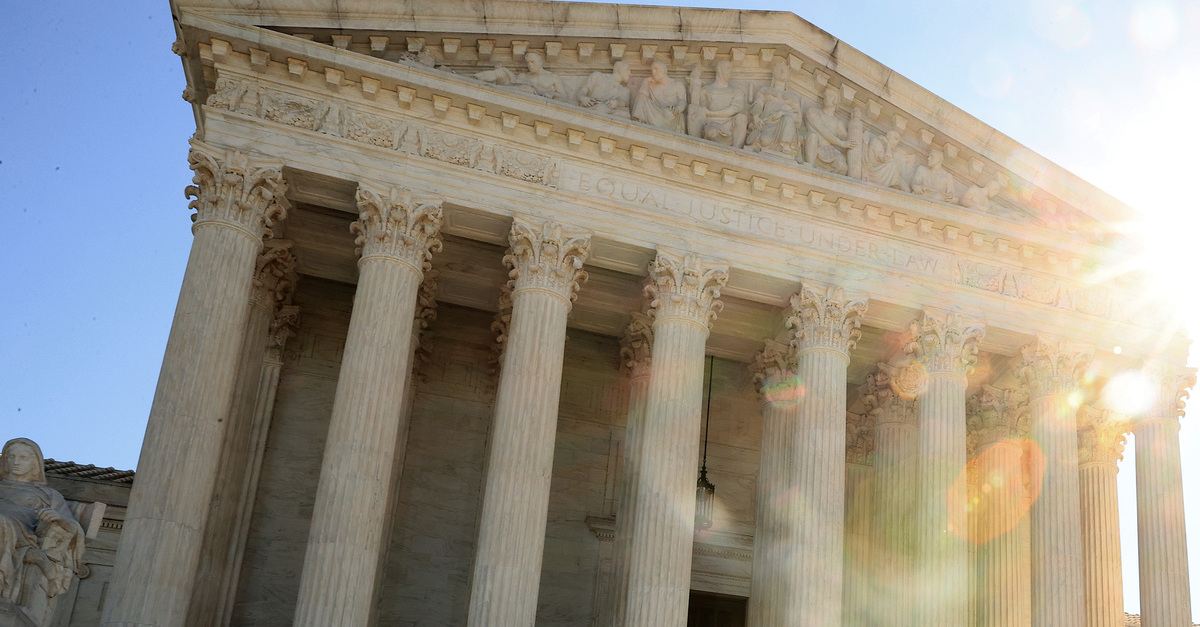
The sun shines on the Supreme Court building in Washington D.C.
Dozens of attorneys who have collectively argued hundreds of cases before the U.S. Supreme Court want Chief Justice John Roberts to maintain public access to livestream audio of oral arguments.
Forty members of the Supreme Court Bar signed their names to an open letter urging the chief justice “to make permanent its policy of livestreaming oral argument audio” as well as a related policy where the audio files are posted on the court’s website the next day.
On April 13, 2020, the Supreme Court announced, for the first time, that the nation’s high court would hear arguments by telephone in response to the COVID-19 pandemic and that such audio would be, again for the first time, remotely accessible to the public.
“In keeping with public health guidance in response to Covid-19, the justices and counsel will all participate remotely,” a press release said. “The court anticipates providing a live audio feed of these arguments to news media. Details will be shared as they become available.”
Though the court’s initial press release specifically referred to news media being able to access such audio, a spokesperson later clarified that the general public would be able to listen in as well.
The first remote cases were heard by the nine justices–and by listeners across the country and world–beginning on May 4, 2020.
Prior to the sea change, the Supreme Court would typically release audio from oral arguments at the end of the week. On just over two dozen occasions, however, the court released audio files on the same day that oral arguments were held, largely in cases that appear to have garnered greater-than-usual public interest.
In response to the pandemic, dozens of courts across the country moved toward audio or video proceedings. After the 2020 election, numerous courts moved back to in-person only proceedings. The Supreme Court never has allowed cameras to film oral arguments.
The open letter praises the changes made to the high court’s “broadcast policy” as an educational boon and credit to legal literacy and transparency–in both formal and informal terms.
“[S]cores of law professors have used the streams as teaching tools of appellate advocacy,” the Supreme Court practitioners write. “Hundreds of media outlets have linked to them so listeners and viewers could hear directly from the justices, unfiltered and in real time, about the issues the Court was grappling with. And tens of thousands of Americans have come to understand the seriousness and the care with which you and your colleagues treat each case and each advocate who comes before the Court.”
Live audio of the proceedings is also carried on C-SPAN, a non-profit cable and satellite station that was formed by a consortium of cable network owners in 1979 as a nonprofit public service news outlet.
According to a C-SPAN/Pierrepont poll released Tuesday, March 15, 2022, some 46 percent of respondents had listened to live audio of a Supreme Court oral argument; 54 percent said they never have.
Those numbers were drastically higher for Zoomers, Millennials and younger Generation X respondents–particularly among those aged 35-49, the only demographic surveyed where a majority said they had tuned into the high court’s feed. Americans over the age of 50 are drastically much less likely to have listened to such audio–or to even know that such access is available to them, according to the poll.
The poll also finds that 65 percent of Americans support the court allowing television coverage of its proceedings.
The letter echoes that concern, saying “some” of the signatories “believe that live audio should one day give way to live video” while acknowledging that issue isn’t before the court “at the moment.”
“Right now, we are focused on audio livestreaming: a policy we wish would continue for as long as you are Chief Justice, and beyond,” the letter concludes. “Thank you for considering our request.”
According to Supreme Court reform organization Fix the Court, the 40 attorneys who signed the letter have, combined, argued some 464 cases before various permutations of the high court over the years.
[image via Chip Somedevilla/Getty Images]
Have a tip we should know? [email protected]